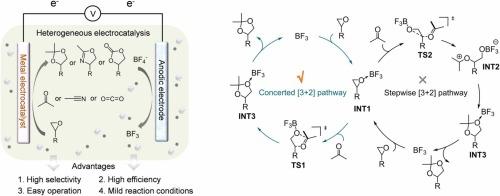A versatile electrocatalytic [3+2] ring expansion approach for efficient electrosynthesis of oxa-/aza-heterocyclic compounds
IF 17.1
1区 材料科学
Q1 CHEMISTRY, PHYSICAL
引用次数: 0
Abstract
Electrosynthesis has emerged as a frontrunner in green chemistry, owing to its benign reaction conditions, high selectivity, tunable operating parameters, and eco-friendly features. Especially, the strategic synthesis of oxygen- and/or nitrogen-heterocyclic compounds holds great importance in across pharmaceutical, agrochemical, fragrance, polymeric, and clean energy sectors. Nevertheless, the electrochemical routes for crafting intricate heterocyclic compounds remain largely underexplored. Herein, we present an electrochemical [3 + 2] ring expansion approach that efficiently produces diverse O- and/or N-containing heterocyclic derivatives (e.g., 1,3-dioxolane, oxazoline, and cyclic carbonate) by fusing cheap and readily accessible precursors, e.g., acetone (CH3COCH3), acetonitrile (CH3CN), or carbon dioxide (CO2) with epoxide skeletons under ambient conditions. Experimental and computational investigations reveal the pivotal roles of cathodic noble metal nanocatalysts (e.g., Pt and Rh) deposited on carbon fibers and Lewis-acidic fluoroborate supporting electrolytes, promoting a kinetically favored concerted pathway over stepwise pathways in the electrocatalytic ring expansion cascade. Our analysis demonstrates that the differing activation energy barriers governing the crucial Lewis adduct [2π + 2σ]-cycloaddition step correlate with the higher reaction rate of acetone over acetonitrile, attributable to stronger electrostatic interactions observed in the acetone-participated reaction as elucidated by electrostatic potential surface analyses of transition states. This work underscores the prowess of electrochemical skeletal editing strategy in facilitating the green production of diversified heterocyclic organic compounds.

一种多功能电催化[3+2]扩环方法用于氧杂环化合物的高效电合成
电合成以其良好的反应条件、高选择性、可调的操作参数和生态友好的特点,已成为绿色化学的领跑者。特别是,氧和/或氮杂环化合物的战略性合成在制药,农化,香料,聚合物和清洁能源领域具有重要意义。然而,制造复杂杂环化合物的电化学途径在很大程度上仍未得到充分探索。在此,我们提出了一种电化学[3+2]环扩张方法,该方法通过在环境条件下将便宜且容易获得的前体,例如丙酮(CH3COCH3),乙腈(CH3CN)或二氧化碳(CO2)与环氧化物骨架融合,有效地生产各种含O和/或含n的杂环衍生物(例如1,3-二恶唑啉和环碳酸盐)。实验和计算研究揭示了阴极贵金属纳米催化剂(例如Pt和Rh)沉积在碳纤维和lewis -酸性氟硼酸盐支撑电解质上的关键作用,在电催化环扩张级联中促进了动力学上有利的协同途径,而不是逐步途径。我们的分析表明,控制关键Lewis加合物[2π+2σ]-环加成步骤的不同活化能垒与丙酮在乙腈上的较高反应速率有关,这是由于在丙酮参与的反应中观察到更强的静电相互作用,正如过渡态的静电势表面分析所阐明的那样。这项工作强调了电化学骨架编辑策略在促进多种杂环有机化合物绿色生产方面的实力。
本文章由计算机程序翻译,如有差异,请以英文原文为准。
求助全文
约1分钟内获得全文
求助全文
来源期刊

Nano Energy
CHEMISTRY, PHYSICAL-NANOSCIENCE & NANOTECHNOLOGY
CiteScore
30.30
自引率
7.40%
发文量
1207
审稿时长
23 days
期刊介绍:
Nano Energy is a multidisciplinary, rapid-publication forum of original peer-reviewed contributions on the science and engineering of nanomaterials and nanodevices used in all forms of energy harvesting, conversion, storage, utilization and policy. Through its mixture of articles, reviews, communications, research news, and information on key developments, Nano Energy provides a comprehensive coverage of this exciting and dynamic field which joins nanoscience and nanotechnology with energy science. The journal is relevant to all those who are interested in nanomaterials solutions to the energy problem.
Nano Energy publishes original experimental and theoretical research on all aspects of energy-related research which utilizes nanomaterials and nanotechnology. Manuscripts of four types are considered: review articles which inform readers of the latest research and advances in energy science; rapid communications which feature exciting research breakthroughs in the field; full-length articles which report comprehensive research developments; and news and opinions which comment on topical issues or express views on the developments in related fields.
 求助内容:
求助内容: 应助结果提醒方式:
应助结果提醒方式:


